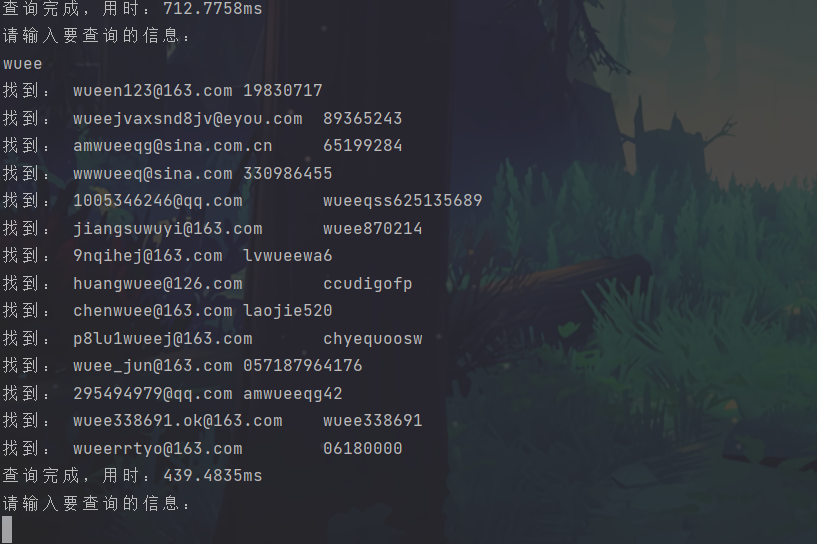**
详情见我的博客小生博客
**
双链表应用——千万数据量秒级查询



原理
利用双链表,
将数据全部读入内存,将读到的数据头插插入双链表,
因为链表头插效率高
然后在内存中检索数据,检索到就输出
代码片段
// 读取文件
file,_ := os.Open(path) // 打开文件
br := bufio.NewReader(file) // 读出文件对象
for{
line,_,end := br.ReadLine()
if end == io.EOF{
break //文件结束跳出循环
}
linestr := string(line)
}
代码
package main
import (
"bufio"
"fmt"
"io"
"os"
"strings"
"time"
)
type DoubleLinkNode struct{
Value interface{}
Next *DoubleLinkNode
Pre *DoubleLinkNode
}
type MyDoubleLinkList struct{
Lens int
Head *DoubleLinkNode
}
func NewDoubleLinkNode(value interface{})*DoubleLinkNode{
return &DoubleLinkNode{
Value: value,
Next: nil,
Pre: nil,
}
}
//func (DoubleLinkNode)
func Constructor()*MyDoubleLinkList{
return &MyDoubleLinkList{
Lens: 0,
Head: nil,
}
}
// GetLength 获取长度
func (this *MyDoubleLinkList)GetLength()int{
return this.Lens
}
// InsertHead 头插
func (this *MyDoubleLinkList)InsertHead(node *DoubleLinkNode){
bak := this.Head
this.Head = node
this.Head.Pre = nil
this.Head.Next = bak
if this.Head.Next!=nil{
this.Head.Next.Pre = this.Head
}
this.Lens++
}
func (this *MyDoubleLinkList)toString(){
node := this.Head
str := ""
fmt.Println("lens:", this.Lens)
for node != nil{
str += fmt.Sprintf("%v-->", node.Value)
node = node.Next
}
str += fmt.Sprintf("nil")
fmt.Println(str)
}
func (this *MyDoubleLinkList)FindStr(value string)interface{}{
node := this.Head
for node!= nil{
if strings.Contains(node.Value.(string), value){
fmt.Println("找到:", node.Value.(string))
}
node = node.Next
}
return false
}
func main() {
l := Constructor()
startTime := time.Now()
pathList := []string{
"D:\\itcast\\社工\\压缩\\猴岛游戏社区\\houdao\\1_1.txt",
"D:\\itcast\\社工\\压缩\\猴岛游戏社区\\houdao\\1_2.txt",
"D:\\itcast\\社工\\压缩\\猴岛游戏社区\\houdao\\1_3.txt",
}
for i:=0; i<len(pathList);i++{
path := pathList[i]
file,_ := os.Open(path) // 打开文件
br := bufio.NewReader(file) // 读出文件对象
for{
line,_,end := br.ReadLine()
if end == io.EOF{
break //文件结束跳出循环
}
linestr := string(line) //转化为字符串
node := NewDoubleLinkNode(linestr) //新建节点
l.InsertHead(node)
}
}
fmt.Printf("内存载入完成, 数据量:%d, 用时:%v", l.GetLength(), time.Since(startTime))
for;;{
fmt.Println("\n请输入要查询的信息:")
var str string
fmt.Scanln(&str)
startTime2 := time.Now()
l.FindStr(str)
fmt.Printf("查询完成,用时:%v", time.Since(startTime2))
}
}